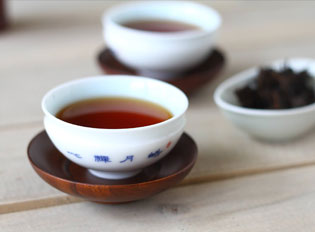Knowledge Centre
The Aesthetics of Tea Appreciation
< Return
Do not hastily turn your back on the brewing utensils or switch to another teapot for another tea, once you have finished brewing and taking the intended rounds. Instead, you may use a small white porcelain dish to have a good look of the tealeaves that have offered their full flavour for your enjoyment, when you are about to part. Take them out from the teapot and lay them on the dish, notice the way they have uncurled and unfurled. Beginning with the appreciation of its subtle aroma, through the enjoyment of its captivating flavour to the final inspection and touch that brings out its visual and tactile beauty, the entire process of tea appreciation is incomplete if any of these is missing. Imagine a person rushing through a place with mesmerizing scenery – leaving without casting another look at the brewed tealeaves would deprive you of the ultimate appreciation of its beauty and allure.
A flower in full bloom or the vista of the setting sun is best admired from different angles as one paces around. Similarly, we can appreciate the brewed tealeaves to our heart’s delight by touching each one of them, feeling it and giving each one a good look. The leaves, in different hues of yellow, green, red, brown, etc, create a colour collage not unlike that of the tropical rainforest. Each leaf is whispering to you her life story. A greenish hue signifies ‘unfermented’ tea with a vegetal fragrance; a pale yellow hue for lightly ‘fermented’ tea with a floral scent; a reddish-orange hue for heavily ‘fermented’ tea with a fruity note; and a brownish-reddish hue for fully ‘fermented’ tea with caramel aroma.
Fully opened leaves enable us to tell if they are just the young buds, or one-bud-two-leaves, one-bud-three-leaves, or fully unfurl mature leaves. The flavour of tender bud is more subtle and refined, while the mature leaves are more pronounced and overwhelming in taste.
As for Oolong, the colour is a clue to the degree of roasting – glossy leaves of golden yellow hue are lightly roasted; duller leaves of light brown hue are medium roasted; and those with dark brown hue are heavily roasted.
Finally, detect the intensity of rolling in the leaves. The less the squeezing, the smoother and flatter the leaves appear, and the more frequent the aroma emission. On the contrary, the more crumbled the leaves, the heavier the squeezing and the less frequent the aroma emission.
If the processing and the tealeaves blend in so well that there is hardly any trace of man’s working, it would be a tea beyond all comparison.
| Author: Hooi Yoke Lien |